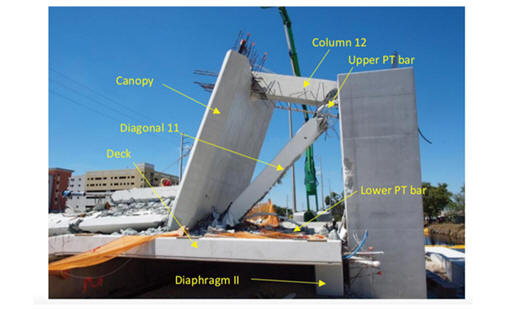OSHA
Investigation Slams FIGG for FIU Bridge
Collapse by Scott Judy
June 12, 2019
The bridge designer adamantly disputes
OSHA’s findings as 'factually inaccurate'

An investigative
report from OSHA's Directorate of
Construction finds that numerous members of
the FIU bridge project's team
made errors in judgment that contributed to
the fatal collapse on March 15, 2018. (Photo
courtesy OSHA)
While criticizing numerous parties involved
with the ill-fated Florida International
University pedestrian bridge project, a
new
report by the Occupational Safety and Health
Administration’s Directorate of Construction
lays considerable blame upon FIGG Bridge
Engineers, the bridge's designer. From
failing to assess the risk from widening
cracks just prior to collapse, to failing to
obtain all of the state-mandated peer
reviews of the bridge’s design, OSHA’s
report details a long list of failures
before the fatal collapse of March 15, 2018.
For instance, FIGG “failed to recognize that
the bridge was in danger of collapsing when
it inspected it hours before the collapse,”
writes Mohammad Ayub, OSHA’s directorate of
construction, the author of the report.
Upon noting the development of numerous
“wide and deep structural cracks” along the
structure’s single concrete truss, “The EOR
(Denney Pate) should have immediately
instructed that the bridge be shored at
appropriate locations and SW 8th Street be
closed.”

Broken Bridge
Column 12, diagonal 11 and part of the
canopy two days after the deck
and diaphragm of the pedestrian bridge
collapsed at Florida International
University.
Moreover, OSHA reports, the bridge “had
structural design deficiencies that
contributed to the collapse during
construction stage III. The cracks on the
bridge occurred due to deficient structural
design.”
The lack of action after a project team
meeting to discuss increasing cracking on
the bridge structure, held the morning of
the collapse, seemed to puzzle OSHA
investigators.
“At that meeting, the EOR acknowledged that
his computations could not replicate the
cracks and therefore, he did not know why
the cracks were occurring,” Ayub writes.
“The Construction Engineer and Inspector
(CEI) of the project advised the EOR at this
meeting that the cracks were lengthening
daily. Despite these admissions and the
knowledge that the cracks were growing in
size, EOR stated more than once that the
cracks did not present any safety concerns.
In a statement to ENR, FIGG disputed OSHA’s
findings, calling the report “factually
inaccurate and incomplete” with “errors and
flawed analyses.”
The OSHA FIU Pedestrian Bridge report “does
not include an evaluation of many important
factors pertinent to the construction
process leading up to the accident.
Additionally, it has not been reviewed by
any other entities involved in the accident
investigation. FIGG disagrees with the
conclusions in the OSHA report.”
The Tallahassee, Fla.-based engineer added:
“As a party member to the NTSB
(investigation) process, we are not able to
elaborate further, but at the appropriate
time the facts and the truth will be
released to the public.”
Other firms failed to take action that could
have prevented the accident, according to
OSHA.
For instance, the design-build contractor,
MCM, “deferred to the decision of EOR and
failed to exercise its own independent
professional judgment, as a constructor of
the bridge, to close the traffic on SW 8th
Street until the cause of the cracks were
conclusively determined by EOR and peer
reviewed,” the report states. OSHA calls the
contractor’s failure to implement necessary
safety measures as “unreasonable.” MCM did
not respond to ENR’s request for comment.
Insufficient peer reviews of the project’s
design, and of FIGG’s analysis of the
cracking, was another factor that OSHA
cited. The report noted that Louis Berger,
the firm FIGG hired to conduct independent
peer reviews, “did not check the structural
integrity of the bridge under different
construction stages, a violation of the FDOT
requirements.”
Additionally, the structure’s unusual
design—which featured a single concrete
truss as its main element—should have
prompted greater caution than FIGG—and other
members of the project team—ultimately
exhibited.
States the report: “EOR should have known
that the truss was a non-redundant structure
and if one diagonal member failed, the
entire bridge could collapse. Given the
nature and extent of the cracking and the
non-redundancy of the bridge design,
necessary safety precautions should have
included closing the roadway below the
bridge and immediately providing shoring to
the bridge at suitable locations until a
complete evaluation was done.”
An investigation by the National
Transportation Safety Board is ongoing.
According to the agency’s own estimates, it
may not publish its findings until later in
2019, or in early 2020.



